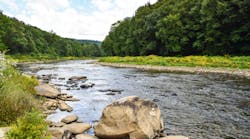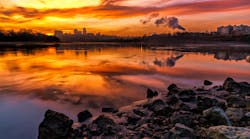Introduction
Approximately 25 miles north of Seattle is a city in Snohomish County called Mukilteo. Mukilteo recently underwent a large-scale ferry expansion project, reviving the aging Mukilteo Ferry Terminal to meet seismic standards, improve transit connections and passenger safety while streamlining passenger loading. This terminal connects Whidbey Island to the Seattle-Everett metropolitan area, the system’s busiest route for vehicle traffic. With this size of project and the proximity to the Puget Sound comes the responsibility to address and enhance stormwater treatment, limiting the vehicle-related hazards and other contaminants from reaching waterways.
Goals
With more than 4 million riders every year, stormwater hazards are inevitable, and the need to address pollutants related to this level of use is vitally important before damage is done to local ecosystems. Contaminants of concern consisted of total suspended solids, hydrocarbons, phosphorus, and metals. Also, treating stormwater with traffic-rated solutions would save land by allowing part of the system to be placed under a parking lot. In addition to these project goals, the selected stormwater system needed to meet the regulatory requirements of the Washington State Department of Ecology (Washington Ecology).
Solution
For the Mukilteo Ferry Terminal project, the Washington State Department of Transportation chose a water quality device that has been elevating stormwater standards for years, the Modular Wetlands Linear. The Modular Wetlands is approved by Washington Ecology for General Use Level Designation (GULD) and is proven to remove pollutants with a combination of physical, chemical, and biological filtration processes. The system mimics natural filtration processes as the only pre-packaged subsurface flow wetland for stormwater treatment, saving land, and yet highly rated for the removal of pollutants such as bacteria, TSS, heavy metals, oils & grease, plastics, and trash.
Furthermore, this project in Mukilteo required a flow rate of .57 CFS, another reason why the Modular Wetlands was chosen. The exceptional versatility and capability to not only treat, but also bypass several CFS, without additional costs of an external bypass, makes this system the clear choice. When Bio Clean’s in-house engineers designed the eight units for this project, the system’s flexibility allowed engineers to utilize a curb inlet and piped flow along with open planter type and traffic-rated units for drive aisles. These eight units ranging in size were used to alleviate and capture the hazardous pollutants found on the Mukilteo site.
Conclusion
Once again, the Modular Wetlands illustrates its ability to adapt and address an array of requirements. The Mukilteo Ferry Terminal project is no different; the scale of this project shows the exceptional versatility and capability of this biofilter by meeting all site and CFS requirements. Now with the upgraded ferry terminal, the Washington State Department of Transportation will know that passengers are safer while the stormwater pollutants such as TSS, hydrocarbons, phosphorus, and metals are being treated before the water is discharged into Puget Sound.
Editor's Note: Scranton Gillette Communications and the SGC Water Group are not liable for the accuracy, efficacy and validity of the claims made in this piece. The views expressed in this content do not reflect the position of the editorial teams of Water & Wastes Digest, Water Quality Products and Storm Water Solutions.






